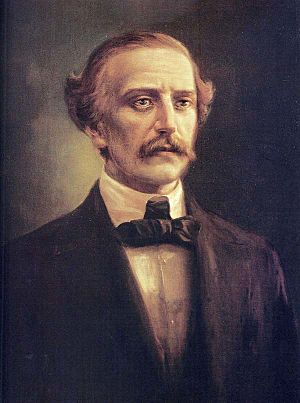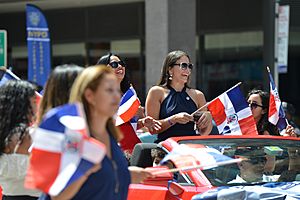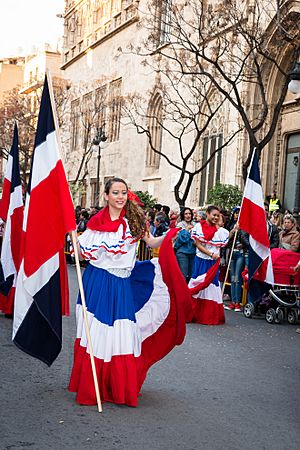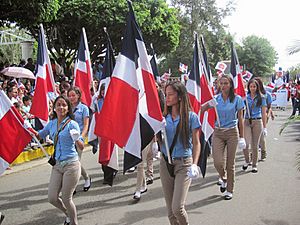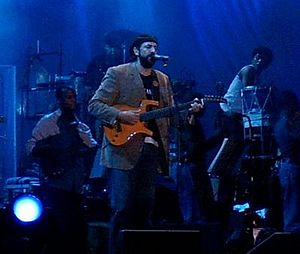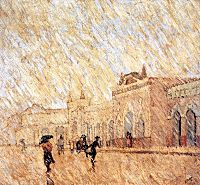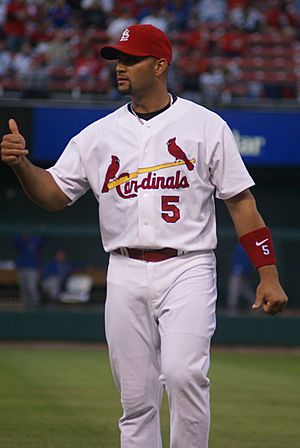People of the Dominican Republic facts for kids
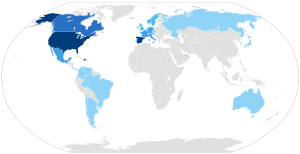
Map of the Dominican people around the world
|
|
| Total population | |
|---|---|
| 14 million Diaspora 2.5 million |
|
| Regions with significant populations | |
| 9,341,916 (2017) | |
| 2,082,857 (2018) | |
| 158,393 (2015 census) | |
| 48,000 (2020)(28,812 as 2022) | |
| 47,000 (2020) | |
| 23,130 | |
| 19,481 (2021) | |
| 14,743 (2015) | |
| 11,154 | |
| 11,091 (2015) | |
| 10,000 | |
| 8,688 (2015) | |
| 8,095 (2015) | |
| 7,000 | |
| 5,000 | |
| 5,000 | |
| 4,000 | |
| 3,843 (2019) | |
| 3,000 | |
| 2,963 (2019) | |
| 2,942 | |
| 2,000 | |
| 2,000 | |
| 2,000 | |
| 2,000 | |
| 1,000 | |
| 1,000 | |
| 1,000 | |
| 1,000 | |
| 1,000 | |
| 235 | |
| 1,000 | |
| Languages | |
| Dominican Spanish | |
| Religion | |
| Predominantly Roman Catholic; Protestant |
|
| Related ethnic groups | |
| Spaniards | |
Dominicans (Spanish: Dominicanos) are people connected to the Dominican Republic. This connection can be through living there, legal citizenship, family history, or shared culture. Most Dominicans have several of these connections, which makes them who they are.
The name "Dominican" was first used for people living in the Captaincy General of Santo Domingo. This was the first Spanish settlement in the Western Hemisphere. Most Dominicans today have roots from the European settlers, with influences from the native Taíno people and African people.
Most Dominicans live in the Dominican Republic. However, many Dominicans also live in other countries. The largest groups are in the United States and Spain. In 2016, the Dominican Republic had about 10.2 million people. About 9.3 million were born in the country. The country has a law where citizenship is based on who your parents are.
Contents
What's in a Name?
The Dominican Republic was once called Santo Domingo. This was the name of its capital city and its patron saint, Saint Dominic. So, the people living there were called "Dominicanos" (Dominicans). When the country became independent, its leaders named it "La República Dominicana."
The word "Dominican" was first written in a letter in 1625. King Phillip IV of Spain wrote it to the people of Santo Domingo. He praised them for defending their land from a Dutch attack. You can find this letter in Spain today.
Another common name for Dominicans is "Quisqueyans." In the Dominican national anthem, the word Quisqueyans is used instead of Dominicans. "Quisqueya" comes from the Taíno language. It means "Great thing" or "Mother of all Lands." It is often used in songs as another name for the country.
A Look at Dominican History
Early History of the Island
Before Europeans arrived, the island was home to the Taíno people. They spoke the Arawakan language. The Taíno were seafarers who came from South America around 650 AD. They divided the island into different areas led by chiefs. They farmed, fished, hunted, and gathered food.
Christopher Columbus and his crew arrived in 1492. They were the first Europeans to meet the Taíno. Columbus described the Taíno as tall and noble people. At first, they had friendly relations. But soon, the Taíno fought against the Spanish takeover. Famous Taíno leaders included Chief Anacaona and Chief Caonabo.
Within a few years, the Taíno population dropped sharply. This was mainly due to diseases like smallpox and measles brought by the Europeans. Records from 1514 show that many Spanish men married Taíno women. Today, many Dominicans have some Taíno ancestors.
European Settlement
Columbus arrived on the island on December 5, 1492. He claimed the land for Spain and named it La Española. He thought it looked like the Spanish landscape. In 1496, Columbus's brother, Bartholomew Columbus, built the city of Santo Domingo. This was the first lasting European settlement in the "New World." For many years, it was the main Spanish base in the Americas.
In 1501, the colony began bringing in African slaves. In 1697, after many fights with the French, Spain gave the western part of the island to France. The central part remained Spanish.
By the mid-1700s, more Europeans came from the Canary Islands. They settled the northern part of the colony. They also started growing tobacco. More slaves were brought to the island. Over time, the differences between races and social classes became less important. This led to a mix of Spanish, African, and native cultures. This mix became the basis of the Dominican identity. By 1777, the colony had about 400,000 people. This included Europeans, Africans, and people of mixed heritage.
Dominican sailors, working for the Spanish Crown, captured British, Dutch, French, and Danish ships in the Caribbean Sea. This happened throughout the 1700s.
Becoming Independent
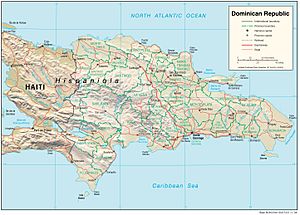
Santo Domingo became the independent Dominican Republic in 1844. This was after 22 years of being ruled by Haiti. Haiti had tried to make Dominicans give up their Spanish language and Latin culture. In 1861, Dominicans chose to rejoin the Spanish Empire. But two years later, they fought a war that brought back their independence in 1865.
After independence, the country had many unstable governments. From 1930 to 1961, Rafael Trujillo ruled as a dictator. His rule was very harsh and caused the deaths of many Dominicans. The Dominican Civil War in 1965 ended with help from the United States. After that, Joaquín Balaguer led the country from 1966 to 1978. Since then, the Dominican Republic has been moving towards a more democratic government.
People and Their Backgrounds
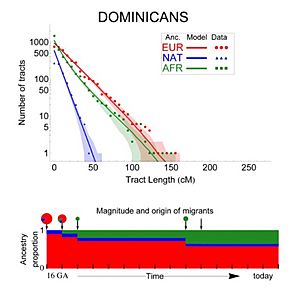
Studies of Dominican DNA show that their background is mostly European and Sub-Saharan African. There is also a smaller amount of Native American ancestry.

In a 2021 survey, most Dominicans (74%) said they were of mixed background. This included terms like Indio, mulatto/moreno, and mestizo/jabao. About 18% identified as white and 8% as black.
Other groups in the country include people from Western Asia. These are mostly Lebanese, Syrians, and Palestinians. There are also smaller groups from East Asia, like Chinese and Japanese. Many Dominicans also have Jewish ancestors. These were Jews who were forced to leave Spain and other areas centuries ago.
Recent research has also found genes from the native people of the Canary Islands (called Guanches) in the Dominican population.
New Arrivals in the 1900s and 2000s
In the 20th century, many Chinese, Arabs, and Japanese came to the Dominican Republic. They worked as farmers and merchants. Waves of Chinese immigrants arrived, some fleeing war. They worked in mines and built railroads. Today, there are about 50,000 Chinese Dominicans. The Arab community is also growing.
People also came from other Caribbean islands. These included places like Saint Kitts and Nevis and Puerto Rico. They worked on sugar plantations and at docks. Many settled in cities like San Pedro de Macorís. There are also a growing number of Puerto Rican immigrants. Before and during World War II, about 800 Jews came to the Dominican Republic. Many of their descendants live in the town of Sosúa.
In 2017, a survey showed that most people with foreign backgrounds were from Haiti. Other groups came from Venezuela, the United States, Spain, and Italy.
Dominicans Living Abroad
Moving to the United States
The first known Dominican to move to what is now the United States was Juan Rodriguez. He arrived in Manhattan in 1613 from Santo Domingo. This made him the first non-Native American person to live there for a long time. He was also the first Dominican and the first Latino in what is now New York City.
Dominicans continued to move to the United States over the centuries. Between 1892 and 1924, about 5,000 Dominican immigrants came through Ellis Island.
In the second half of the 20th century, there were three big waves of Dominicans moving to the United States. The first started in 1961 after dictator Rafael Trujillo was killed. People feared what would happen next. In 1965, the United States made it easier for Dominicans to get visas. This led to more people leaving. From 1966 to 1978, many left due to high unemployment and political problems. Dominican communities already in the U.S. helped new arrivals. In the early 1980s, even more Dominicans left. This was because of unemployment and rising prices. Today, many Dominicans still move to the United States. They are often helped by the strong Dominican communities already there.
Besides the United States, many Dominicans have also settled in Spain and Puerto Rico.
Where Dominicans Move To
Many Dominicans live outside their home country. The largest groups are in the United States (over 1 million) and Spain (over 150,000). Other countries with many Dominicans include Italy, Venezuela, Switzerland, and Germany.
Where People Move to the Dominican Republic From
The Dominican Republic also has people who have moved there from other countries. The largest group of immigrants is from Haiti. Other significant groups come from the United States, Spain, Venezuela, and Cuba.
Dominican Culture
The culture of the Dominican Republic is a mix of European, African, and Taíno influences. This is similar to other Caribbean countries. Spanish is the official language. Other languages like English and French are also spoken. You can see European, African, and Taíno influences in food, family life, religion, and music. Many Taíno words are used in daily talk and for local foods.
National Symbols
Important symbols of the Dominican Republic include its flag, coat of arms, and national anthem. The flag has a large white cross that divides it into four parts. Two parts are red, and two are blue. Red stands for the blood shed by those who fought for freedom. Blue shows God's protection. The white cross means the fight for a free nation. Another idea is that blue means progress and freedom, and white means peace and unity.
In the middle of the flag's cross is the Dominican coat of arms. It has the same colors as the flag. The coat of arms shows a shield with a Bible, a gold cross, and arrows. An olive branch is on the left, and a palm branch is on the right. The Bible means truth and light. The gold cross means freedom from slavery. The arrows stand for brave soldiers. A blue ribbon above the shield says, "Dios, Patria, Libertad" (God, Fatherland, Liberty). A red ribbon below says, "República Dominicana." The Dominican flag is unique because it is the only national flag in the world with a Bible on it.
The national flower is the Bayahibe Rose. The national tree is the West Indian Mahogany. The national bird is the Cigua Palmera, also known as the Palmchat.
Language
Spanish is the main language in the Dominican Republic. The local way of speaking Spanish is called Dominican Spanish. It is similar to Spanish spoken in the Canary Islands and Andalusia in Spain. It also has words from Taíno languages. Schools teach in Spanish. English and French are taught as second languages. Haitian Creole is spoken by people of Haitian background. There is also a small group of about 8,000 people who speak Samaná English. They are descendants of formerly enslaved African Americans who came in the 1800s. Many Dominicans learn English because of tourism, American pop culture, and economic ties with the United States.
Religion
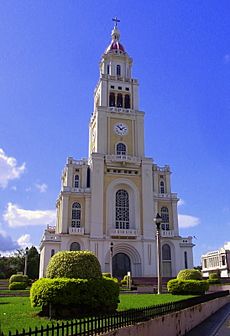
Most Dominicans (80%) are Christian. This includes 57% Roman Catholic and 23% Protestant. Other religions are also present due to immigration. These include Spiritists, Latter-day Saints, and others.
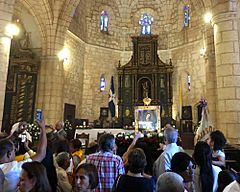
Catholicism came with Columbus and Spanish missionaries. While not the only focus of society, Catholic teachings were important. The Bible was required in schools. Children would often say "Bless me, mother" to their parents, who would reply, "May God bless you." The country has two patron saints: Nuestra Señora de la Altagracia (Our Lady Of High Grace) and Nuestra Señora de las Mercedes (Our Lady Of Mercy). The Catholic Church became less popular in the late 1800s. At the same time, the Protestant evangelical movement grew. There has been little religious tension between Catholics and Protestants.
There has always been religious freedom in the country. Only in the 1950s did dictator Trujillo place limits on churches. He tried to stop priests and bishops who spoke against his government. But this plan ended when he was killed.
Judaism came to the Dominican Republic in the late 1930s. During World War II, Jewish refugees escaping Nazi Germany came here. They founded the town of Sosúa, which is still a center for the Jewish population.
Food and Drinks
Dominican food mixes Spanish, Native American, and African influences. It is similar to food in other Latin American countries, but dishes have different names. A common breakfast is eggs and mangú (mashed plantains). Sometimes, fried meat or cheese is added. Lunch is usually the biggest meal. It often includes rice, meat (chicken, beef, pork, or fish), beans, plantains, and a salad. "La Bandera" (The Flag) is a popular lunch dish. It has meat and red beans on white rice. "Sancocho" is a famous national soup made with seven types of meat.
Dominican meals usually have meat or seafood, rice, potatoes, or plantains, and some vegetables. But they often have more starches and meats than dairy or vegetables. Many dishes use sofrito, a mix of local herbs and spices. Other favorite foods include chicharrón, yuca, casabe, and pastelitos (empanadas).
Sweet treats include arroz con dulce (rice pudding), bizcocho dominicano (Dominican cake), and habichuelas con dulce (sweet creamed beans). Popular drinks are Morir Soñando, rum, beer, and fresh fruit juices.
Music and Dance
The Dominican Republic is famous for creating merengue music. Merengue is a lively, fast-paced dance music. It uses drums, brass, and other instruments. It also features the tambora (Dominican drum), accordion, and güira. Merengue became popular around the world in the mid-1900s. Famous merengue singers include Juan Luis Guerra and Johnny Ventura. Merengue became very popular in the United States in the 1980s and 90s.
Bachata is another popular music and dance style. It started in the countryside. Bachata songs are often about love, heartbreak, and sadness. Its original name was amargue, meaning "bitterness." Bachata is related to the Latin American bolero style. It has also been influenced by merengue.
Salsa music is also very popular. In the late 1960s, Dominican musicians like Johnny Pacheco helped create and popularize salsa.
Recently, Dominican rap has become popular, especially among young people. It is also called Rap del Patio (yard rap). It started in the early 2000s. Successful rappers include Lapiz Conciente and Vakero. Dominican rap is different from reggaeton. It uses more hip-hop beats and focuses on city themes like money and poverty.
Visual Arts
Dominican art is often known for its bright colors. But the country has a long history of fine art. This goes back to the mid-1800s when the country became independent. Early paintings showed national independence, historical scenes, and portraits. Styles included neoclassicism and romanticism. From 1920 to 1940, art was influenced by realism and impressionism. Artists wanted to create their own unique styles. Important artists from this time were Celeste Woss y Gil and Darío Suro.
The 1940s were an important time for Dominican art. President Rafael Leónidas Trujillo offered safety to refugees from the Spanish Civil War. Many European artists came to the Dominican Republic. They inspired young Dominican artists to see art from a global view. The Escuela Nacional de Bellas Artes was founded as the first official art school. The country experienced a rebirth in art, inspired by European trends.
From 1950 to 1970, Dominican art showed the social and political issues of the time. Artists wanted new ways to express themselves. They created paintings in abstract, geometric, and cubist styles. Key artists included Paul Giudicelli and Clara Ledesma.
In the 1970s and 1980s, artists tried new styles and ideas again. Artists like Ada Balcácer and Ramón Oviedo were very influential.
Movies
Dominican cinema is a growing film industry. It was one of the first Latin American countries to have movies. The Lumière brothers brought film to Puerto Plata in 1900. The first film made in the Dominican Republic was in 1915.
The Dominican Film Market (DFM) is the first film market in the Caribbean. It helps promote Dominican films.
Fashion
In just seven years, the Dominican Republic's fashion week has become very important. It is the biggest fashion event in the Caribbean. The country has one of the top design schools in the region, La Escuela de Diseño de Altos de Chavón. This makes the country a key player in fashion.
World-famous fashion designer Oscar de la Renta was born in the Dominican Republic in 1932. He later became a US citizen. He studied with famous designers and started his own label. His designs mix French, Spanish, and American styles. He was very popular in Latin America. He also did charity work in the Dominican Republic.
Sports
Baseball is by far the most popular sport in the Dominican Republic. After the United States, the Dominican Republic has the second-highest number of Major League Baseball (MLB) players. Many of these players are considered among the best in the game.
Ozzie Virgil Sr. was the first Dominican to play in MLB. Juan Marichal was the first Dominican-born player in the Baseball Hall of Fame. Other great MLB players from the Dominican Republic include Manny Ramirez, David Ortiz, Pedro Martínez, and Albert Pujols.
Olympic gold medalist Félix Sánchez is from the Dominican Republic. He is a world champion in 400-meter hurdles. Luis Castillo is a defensive end for the San Diego Chargers in the National Football League (NFL).
The National Basketball Association (NBA) has also had players from the Dominican Republic. These include Charlie Villanueva and Al Horford. Boxing is another important sport after baseball. The country has produced many world-class boxers and champions.
Holidays
| Date | Name | |
|---|---|---|
| January 1 | New Year's Day | A day off from work. |
| January 6 | Catholic day of the Epiphany | Date can change. |
| January 21 | Día de la Altagracia | A day off from work. It's a special day for the country's patroness saint (Catholic). |
| January 26 | Duarte's Day | Date can change. Honors a founding father. |
| February 27 | Independence Day | A day off from work. This is the country's national day. |
| (Variable date) | Holy Week | Most days are working days, except Good Friday. A Catholic holiday. |
| May 1 | International Workers' Day | Date can change. |
| Last Sunday of May | Mother's Day | |
| (Variable date) | Catholic Corpus Christi | A day off from work. It's a Thursday in May or June (60 days after Easter Sunday). |
| August 16 | Restoration Day | A day off from work. |
| September 24 | Virgen de las Mercedes | A day off from work. Another special day for a patroness saint (Catholic). |
| November 6 | Constitution Day | Date can change. |
| December 25 | Christmas | A day off from work. |
Notes:
- Holidays that are "non-working" do not move to another day.
- If a holiday that can move falls on Saturday, Sunday, or Monday, it stays on that day. If it falls on Tuesday or Wednesday, it moves to the previous Monday. If it falls on Thursday or Friday, it moves to the next Monday.
Notable People
- List of people from the Dominican Republic
See Also
 In Spanish: Dominicanos para niños
In Spanish: Dominicanos para niños
- Dominican American
- Dominican-Puerto Rican
- List of Dominican Americans
- Dominicans in Spain
- Culture of the Dominican Republic
- Demographics of the Dominican Republic
- History of the Dominican Republic
- White Dominicans
- Afro-Dominicans
- Hispanics


